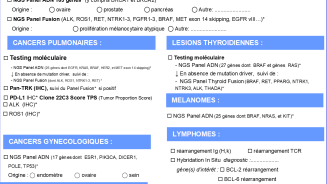Molecular pathology
The techniques of molecular pathology are used to highlight molecular changes that are specific to a pathology, in most cases a cancerous pathology. This discipline permits a more precise diagnosis or prognosis and thus orientates treatment.
In recent years the number of molecular changes tested has increased considerably while the samplings have become smaller in size (biopsic or cytological). This brings a new challenge for the pathologist, namely to obtain a precise morphological diagnosis as well as a molecular characterisation of the tumour on increasingly small samples. In addition, the results must be given as rapidly as possible so that patients can receive the appropriate treatment without delay.
Molecular pathology plays a vital role in the diagnosis, the inclusion of molecular changes in the anatomopathological diagnosis constituting a major turning point for this speciality. Day after day, new diagnostic entities are defined by specific molecular changes that must be included in the conventional clinical and morphological data to provide the patient with the best possible diagnosis.
Molecular pathology is one of the pillars of precision medicine in regard to the patient’s treatment (theranostic role). The identification of specific molecular changes makes it possible to provide patients with a targeted treatment. The application of molecular pathology in theranostics has developed markedly in recent years thanks to the exponential development of targeted treatments.
Aware of these new needs, at the Pathological Anatomy Laboratory we have developed a molecular pathology section dedicated to the cancerous pathology. The genomic methods of investigation, including in situ (ISH) hybridisation and PCR techniques (PCR, IdyllaTM, qPCR, digital PCR, etc.), are currently available to identify these biomarkers. The Pathological Anatomy Laboratory has also implemented New Generation Sequencing (NGS) technology that enables us to optimise the molecular characterisation of tumours. On the basis of paraffin-coated tissue and small tumour samples, it is possible to study the presence of mutations of several dozen genes involved in cancerogenesis. This continuously evolving technique assists a personalised approach to the treatment of cancer patients in everyday practice.
The fields of application of these molecular tests are set out below.
For any request for an examination please complete the ad hoc forms below:
- Demande d’analyse de Biologie Moléculaire et Immunohistochimie
- Demande de Recherche de mutation du gène EGFR sur ADN tumoral circulant
* Ces tests sont réalisés sous couvert du certificat d'accréditation BELAC n°727-MED, conformément à la norme ISO 15189.
Liste des 22 gènes analysés dans le Colon and Lung Panel : AKT1, ALK, BRAF, CTNNB1, DDR2, EGFR, ERBB2, ERBB4, FBXW7, FGFR1, FGFR2, FGFR3, KRAS, MAP2K1, MET, NOTCH1, NRAS, PIK3CA, PTEN, SMAD4, STK11, TP53
Liste des 25 gènes analysés dans l’Oncomine Solid Tumor Panel : les 22 gènes du Colon and Lung Panel + HRAS, KIT, PDGFRA
Liste des 50 gènes analysés dans le Cancer Panel : ABL1, AKT1, ALK, APC, ATM, BRAF, CDH1, CDKN2A, CSF1R, CTNNB1, EGFR, ERBB2, ERBB4, EZH2, FBXW7, FGFR1, FGFR2, FGFR3, FLT3, GNA11, GNAQ, GNAS, HNF1A, HRAS, IDH1, IDH2, JAK2, JAK3, KDR, KIT, KRAS, MET, MLH1, MPL, NOTCH1, NPM1, NRAS, PDGFRA, PIK3CA, PTEN, PTPN11, RB1, RET, SMAD4, SMARCB1, SMO, SRC, STK11, TP53, VHL
Liste des 39 gènes analysés dans le Clinical Glioma Panel : ACVR1, ATRX, BRAF, CDK4, CDK6, CDKN2A, CDKN2B, EGFR, FGFR1, FGFR2, FGFR3, H3F3A (=H3.3), H3F3B,HIST1H3B (=H3C2), HIST1H3C (=H3C3), HRAS, IDH1, IDH2, KRAS, MDM2, MDM4, MYCN, NF1, NF2, NRAS, PDGFRA, PIK3CA, PIK3R1, POLD1, POLE, PPM1D, PRKCA, PTEN, PTPN11, RB1, TERT, TP53, TSC1, TSC2
Liste des 27 gènes analysés dans le Thyroid Panel : AKT1, APC, AXIN1, BRAF, CDH1, CDKN2A, CHEK2, CTNNB1, EGFR, EIF1AX, FLT3, GNAS, HRAS, IDH1, KRAS, NRAS, PIK3CA, PPM1D, PRKAR1A, PTEN, RASAL1, RET, SMAD4, TERT, TP53, TSHR, VHL
Panel Fusion ONCOMINE FOCUS RNA (OFA) : détection de 271 transcrits de fusion impliquant 23 gènes : ABL1, AKT3, ALK, AXL, BRAF, EGFR, ERBB2, ERG, ETV1, ETV4, ETV5, FGFR1, FGFR2, FGFR3, MET, NTRK1, NTRK2, NTRK3, PDGFRA, PPARG, RAF1, RET, ROS1
Panel Thyroid Fusion : détection de 66 transcrits de fusion impliquant 7 gènes : ALK, BRAF, THADA, NTRK1, NTRK3, PPARG, RET
Panel Fusion sarcome : détection de transcrits de fusion impliquant 61 gènes : LK, BCOR, BRAF, CAMTA1, CCNB3, CIC, CSF1, EGFR, EPC1, ERG, ESR1, ETV1, ETV4, ETV5, ETV6, EWSR1, FGFR1, FGFR2, FGFR3, FOS, FOSB, FOXO1, FUS, GLI1, HMGA2, JAZF1, MBTD1, MDM2, MEAF6, MET, MGEA5, MKL2, NCOA1, NCOA2, NCOA3, NR4A3, NTRK1, NTRK2, NTRK3, NUTM1, PAX3, PDGFB, PDGFRA, PHF1, PLAG1, PRKCA, PRKCB, PRKCD, RAF1, RET, ROS1, SS18, STAT6, TAF15, TCF12, TFE3, TFG, USP6, VGLL2, YAP1, YWHAE.
